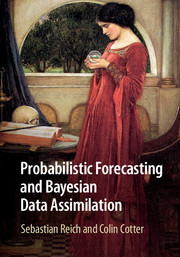1 - Prologue: how to produce forecasts
Published online by Cambridge University Press: 05 May 2015
Summary
This chapter sets out a simplified mathematical framework that allows us to discuss the concept of forecasting and, more generally, prediction. Two key ingredients of prediction are: (i) we have a computational model which we use to simulate the future evolution of the physical process of interest given its current state; and (ii) we have some measurement procedure providing partially observed data on the current and past states of the system. These two ingredients include three different types of error which we need to take into account when making predictions: (i) precision errors in our knowledge of the current state of the physical system; (ii) differences between the evolution of the computational model and the physical system, known as model errors; and (iii) measurement errors in the data that must occur since all measurement procedures are imperfect. Precision and model errors will both lead to a growing divergence between the predicted state and the system state over time, which we attempt to correct with data which have been polluted with measurement errors. This leads to the key question of data assimilation: how can we best combine the data with the model to minimise the impact of these errors, and obtain predictions (and quantify errors in our predictions) of the past, present and future state of the system?
Physical processes and observations
In this book we shall introduce data assimilation algorithms, and we shall want to discuss and evaluate their accuracy and performance. We shall illustrate this by choosing examples where the physical dynamical system can be represented mathematically. This places us in a somewhat artificial situation where we must generate data from some mathematical model and then pretend that we have only observed part of it. However, this will allow us to assess the performance of data assimilation algorithms by comparing our forecasts with the “true evolution” of the system.
- Type
- Chapter
- Information
- Publisher: Cambridge University PressPrint publication year: 2015



